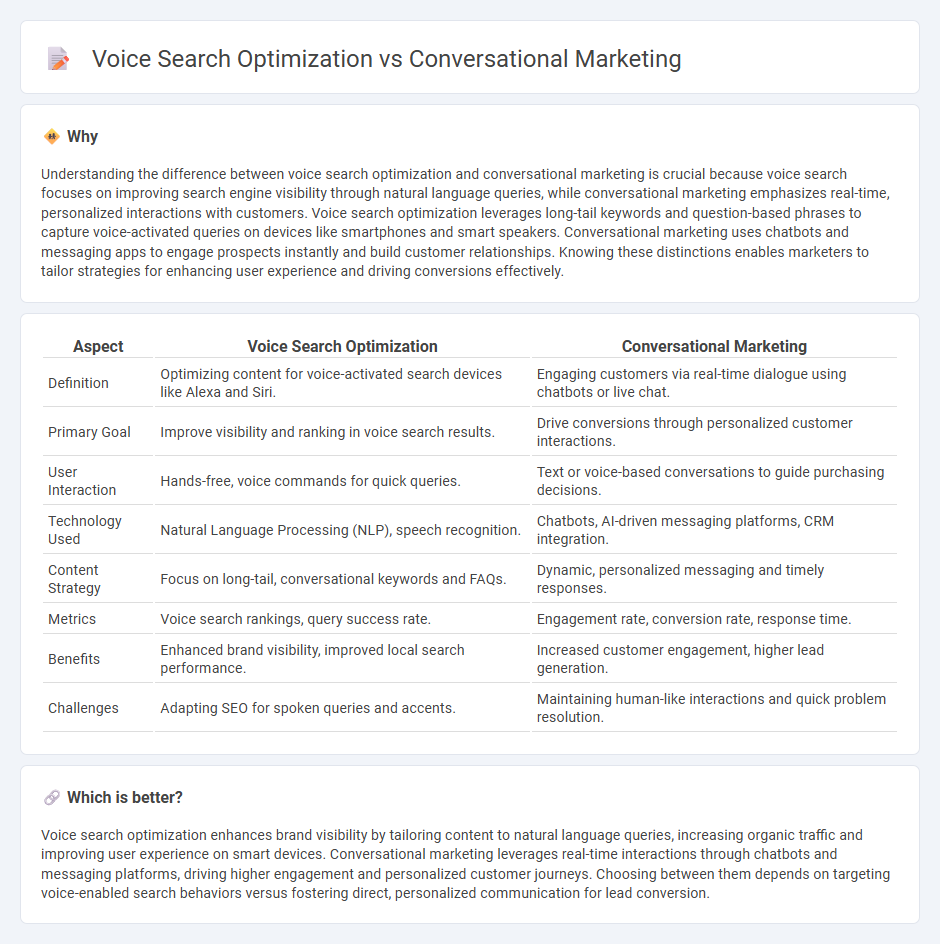
Voice search optimization leverages natural language processing to enhance search engine rankings for voice queries, improving user engagement through precise keyword targeting. Conversational marketing focuses on real-time interactions using chatbots and messaging platforms, driving personalized customer experiences and higher conversion rates. Explore effective strategies to integrate both approaches for a comprehensive marketing advantage.
Why it is important
Understanding the difference between voice search optimization and conversational marketing is crucial because voice search focuses on improving search engine visibility through natural language queries, while conversational marketing emphasizes real-time, personalized interactions with customers. Voice search optimization leverages long-tail keywords and question-based phrases to capture voice-activated queries on devices like smartphones and smart speakers. Conversational marketing uses chatbots and messaging apps to engage prospects instantly and build customer relationships. Knowing these distinctions enables marketers to tailor strategies for enhancing user experience and driving conversions effectively.
Comparison Table
| Aspect | Voice Search Optimization | Conversational Marketing |
|---|---|---|
| Definition | Optimizing content for voice-activated search devices like Alexa and Siri. | Engaging customers via real-time dialogue using chatbots or live chat. |
| Primary Goal | Improve visibility and ranking in voice search results. | Drive conversions through personalized customer interactions. |
| User Interaction | Hands-free, voice commands for quick queries. | Text or voice-based conversations to guide purchasing decisions. |
| Technology Used | Natural Language Processing (NLP), speech recognition. | Chatbots, AI-driven messaging platforms, CRM integration. |
| Content Strategy | Focus on long-tail, conversational keywords and FAQs. | Dynamic, personalized messaging and timely responses. |
| Metrics | Voice search rankings, query success rate. | Engagement rate, conversion rate, response time. |
| Benefits | Enhanced brand visibility, improved local search performance. | Increased customer engagement, higher lead generation. |
| Challenges | Adapting SEO for spoken queries and accents. | Maintaining human-like interactions and quick problem resolution. |
Which is better?
Voice search optimization enhances brand visibility by tailoring content to natural language queries, increasing organic traffic and improving user experience on smart devices. Conversational marketing leverages real-time interactions through chatbots and messaging platforms, driving higher engagement and personalized customer journeys. Choosing between them depends on targeting voice-enabled search behaviors versus fostering direct, personalized communication for lead conversion.
Connection
Voice search optimization enhances the accuracy of responses by aligning content with natural language queries, directly feeding into conversational marketing strategies that rely on real-time, interactive customer engagement. Integrating AI-powered chatbots with voice-activated assistants streamlines the customer journey by providing personalized, context-aware interactions based on voice search data. This synergy boosts conversion rates and customer satisfaction by delivering seamless, voice-enabled experiences tailored to user intent.
Key Terms
Conversational marketing:
Conversational marketing leverages real-time, personalized interactions through chatbots and messaging platforms to enhance customer engagement and drive conversions. By utilizing natural language processing and AI, businesses can deliver tailored experiences that increase lead generation and shorten sales cycles. Explore effective strategies to implement conversational marketing and boost your business growth.
Chatbots
Conversational marketing leverages chatbots to engage customers in real-time, delivering personalized experiences that drive conversions and build brand loyalty. Voice search optimization enhances chatbot functionality by enabling natural language processing and understanding voice commands to improve user interactions. Explore how integrating chatbots with voice search optimization can revolutionize customer engagement and boost business growth.
Real-time engagement
Conversational marketing leverages real-time interaction through chatbots and messaging platforms, enhancing customer engagement by providing instant, personalized responses. Voice search optimization prioritizes natural language processing and keyword tailoring to capture voice queries effectively and improve search engine rankings. Explore strategic techniques to maximize real-time engagement in both conversational marketing and voice search optimization.
Source and External Links
What is conversational marketing? - TechTarget - Conversational marketing engages customers through real-time, two-way dialogue, focusing on personalized interactions via live chat, chatbots, and other channels to streamline the customer journey and build stronger relationships.
The Beginner's Guide to Conversational Marketing - HubSpot Blog - This approach enables scalable, customer-led conversations that can happen anytime, leveraging both automation and human touchpoints to meet customer needs efficiently.
What Is Conversational Marketing? - IBM - Brands use conversational marketing to deliver personalized, real-time engagement across digital channels like social media, email, and messaging apps, anticipating customer needs and enhancing overall user experience.
 dowidth.com
dowidth.com